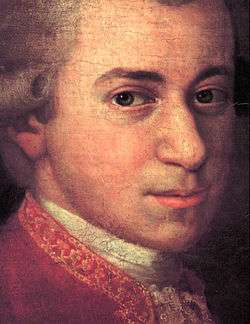Violin Sonatas, KV 26–31 (Mozart)
Wolfgang Amadeus Mozart's set of six sonatas for keyboard and violin, K. 26–31 were composed in early 1766 in The Hague during the Mozart family's grand tour of Europe. They were dedicated to Princess Caroline of Nassau-Weilburg on the occasion of the eighteenth birthday of her brother, the Prince of Orange.[1] They were published as Mozart's "Opus 4".
These works show an improvement in compositional technique over the sets for Paris (KV 6–9) and London (KV 10–15),[1] although like the previous sets, the keyboard part dominates and the violin may be considered optional.
Mozart composed all three early sets of accompanied sonatas while touring northwest Europe. These types of sonatas were not favored at home in Salzburg.[1] Mozart would not revisit this genre until 1777–78 on a trip to Mannheim and Paris.
Sonata in E-flat, K. 26
- Allegro molto
- Adagio poco andante
- Rondeaux (Allegro)
Sonata in G, K. 27
- Andante poco adagio
- Allegro
Sonata in C, K. 28
- Allegro maestoso
- Allegro grazioso
Sonata in D, K. 29
- Allegro molto
- Menuetto and Trio
Sonata in F, K. 30
- Adagio
- Rondeaux (Tempo di Menuetto)
Sonata in B-flat, K. 31
- Allegro
- Tempo di Menuetto (Moderato)
Notes
External links
- Sonata in Es KV 26: Score and critical report (German) in the Neue Mozart-Ausgabe
- Sonata in G KV 27: Score and critical report (German) in the Neue Mozart-Ausgabe
- Sonata in C KV 28: Score and critical report (German) in the Neue Mozart-Ausgabe
- Sonata in D KV 29: Score and critical report (German) in the Neue Mozart-Ausgabe
- Sonata in F KV 30: Score and critical report (German) in the Neue Mozart-Ausgabe
- Sonata in B KV 31: Score and critical report (German) in the Neue Mozart-Ausgabe
- "MozartForum notes on early Mozart compositions". Archived from the original on 30 November 2013.
